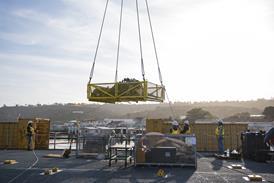Boeing is reshaping the way it produces airliners to reduce costs and speed up deliveries
Guy Norris/Seattle

To most, burgers and airliners do not readily mix. Yet, as Boeing fights hard to reduce costs, cycle times and defects, the fast-food production concept is exactly the sort of philosophy it is trying to emulate. Although radically different in detail, the "burger" approach combines elements of the main initiatives now being introduced to keep Boeing Commercial Airplane Group (BCAG) profitable in the 21st century.
Two of the major planks of this strategy are DCAC/MRM and lean manufacturing. The unwieldy acronym stands for Define and Control Aircraft Configuration/Manufacturing Resource Management. Lean manufacturing focuses on continuously cutting waste from production processes, maximising efficiency, improving quality and safety, minimising inventory and saving time.
The two initiatives, and others, are now being implemented throughout BCAG. Crucially to Boeing, they cannot happen soon enough. Although the improvements feed into the company's all-embracing "Vision 2016" policy for the future, everyone at Boeing recognises the urgency of improving processes now. Faced with a massive order backlog and huge production problems, the initiatives have become key to the survival of the company. "We all knew that, if we couldn't fix it, we wouldn't be around to fix it," says BCAG president Ron Woodard, who is credited with starting the move towards DCAC/MRM in 1993.
Only partial benefits of the production initiatives have yet been felt, however, and full implementation is at least a year behind schedule. With financial results suffering and Wall Street looking for a turnaround, there is also enormous external pressure to get the improvements into action. Many at Boeing give credit to management for sticking to the DCAC/MRM goals throughout the problems, which others in the company say could have been eased by diverting resources away from the initiatives.
To DCAC/MRM programme director Garnet Hizzey, perseverance was paramount. "There is no 'Plan B'. We have no choice. It's been a tougher job to execute than we imagined, though we think we're through the worst of it now that people understand the need for change. It seems so long ago that we were investing, investing, investing. Now we're coming out of the hole," says Hizzey, who expects full implementation by the end of 1999.
COUNTING COWS
To explain the initiatives, Lean Manufacturing Office director John Black compares an aircraft factory to a fast-food chain restaurant such as McDonalds. "DCAC defines, configures and controls the different models of burger. MRM manages the resources needed to produce them by assessing the number of burgers needed per month, seasonal fluctuations and differences in demand depending on location. They work out how many cows, potatoes and how much recyclable paper is required.
"Once you get to the shop floor, or restaurant in this case, then that's when lean [manufacturing] comes in. Lean is 'production levelled' which means regardless of the number of customers coming in and the type of burgers ordered, you can produce and sell them without increasing the waiting time, creating more space or hiring more people".
With fast food probably the last thing on their minds, a Boeing team began laying the foundation for DCAC/MRM when it began looking closely at BCAG's business practices in 1993. "It became clear that aircraft were costing way too much money to build. The fundamental cost driver was the way we configured our aircraft," says Hizzey, who adds that the process was "essentially Second World War vintage". Unlike the US armed forces, which wanted hundreds of exactly the same model, Boeing's airline customers wanted more and more variety. "It led to complexity and errors, and began to pollute the production requirements process," he says.
Boeing was contributing to the problem by being "-more than willing to satisfy customer requirements. But the cost exceeded the benefits. That was okay if we were still making money, but bargaining got tougher, negotiations got harder and we had slimmer margins. We simply had to force our internal costs down. That's the focus of DCAC/MRM," Hizzey says.
One of the biggest reasons for moving to the new process was the hard experience of developing the 747-400. "It was sort of a disaster and we brought it on ourselves. The first three aircraft had three different engines. Talk about shooting yourself in the foot, we practically emptied a whole clip into ours," recalls Hizzey. Problems were made worse by the huge number of alternative interior configurations. "With all the real estate on the 747, the customers went hog wild with configurations. The main lesson learned was the development of the flexible interior concept which went in the 777," he adds.
Because of events like the 747-400 experience, DCAC/MRM sets out to perform three main tasks. First, it simplifies the configuration management process by replacing the customer identification code assigned to engineering drawings with an automated system of configuration control. Each aircraft will be assigned a unique "tail" number, similar to a vehicle's identification number, that will be used to identify all the aircraft's components by part number.
Second, DCAC/MRM "tailors" the business stream to suit the degree of variability in each aircraft model. There are three streams: TBS-1, which is basic and stable for the parts that are common on each model; TBS-2, which covers available options that have already been engineered and delivered to a customer - like galleys and interiors; and TBS-3, which covers unique items. "These can be exotic or mundane, and range from things like gold-plated faucets to cup holders in the cockpit," says Hizzey. "TBS-3 items tend to be money losers and very disruptive, but the motivation was that if we could sell from a catalogue we would get economies of scale and get into a repetitive process."
Third, the initiative has developed the Single Source of Product Data (SSPD) that includes a "single bill of material". The data are structured so that everybody who needs access can have it. "The old system had 14 or 15 different bills of material, and when you multiply that by around 1,500 legacy computer systems, then it's easy to see why the data became difficult to keep in synchronisation. This led to a lot of discrepancies," he says. Using the product data source, DCAC/MRM is implementing simplified methods of tracking and ordering parts, scheduling production and managing inventory for each tailored business stream.
New computers have been bought to ensure that DCAC/MRM works. These will replace existing systems at a ratio of around 1:100, but "-we've only got rid of 116, so we're just starting to see the benefits of what we're doing", says Hizzey. Major hardware includes over 300 clustered Hewlett-Packard HP 9000 Series 800 servers. Software includes Baan International's Baan IV, which manages the flow of parts, inventory and financial transactions, and CIMLINC's Linkage Solutions, for planning how parts are built or assembled on the aircraft.
Metaphase product data management software from Structural Dynamics Research "-is the guts of the system", according to Hizzey. Metaphase provides access to the SSPD, and is the foundation for the entire DCAC/MRM operation. As product data manager, it houses the aircraft configuration library and information on parts, plans, tools, documents and technical publications as well as service bulletins, retrofit kits, modifications, reliability and maintainability. It also produces order and quantity data to help compile a production forecast, as well as to support schedule planning and inventory management.
When an airline goes to Boeing today, the effects of DCAC/MRM kick in immediately. The first break with tradition is the use of a laptop computer, called the "Configurator", running SalesBUILDER configuration software from Trilogy. The software accesses data from the SSPD's configuration library to allow the aircraft to be configured on the spot.
This long delayed, but vital, element of DCAC/MRM was implemented on 1 July. The customer begins by choosing the major aircraft type (from the TBS-1 stream), followed by a specific model and selected options from TBS-2. If the customer wants something "not in the catalogue", the Configurator moves to TBS-3, and the price rise is calculated.
Once configuration is complete, the Configurator generates a list of selected options and the aircraft's unique identification number. Configuration data is then passed on to the "Define" group (or "macro-process", in Boeing parlance) where the job of converting the customer's wishlist into reality begins. Define engineers download the selected options from the SSPD and match them to modules. The modules contain everything covered by the option including parts, plans, tools and documents. The modules are compiled into a single table and the aircraft is "defined".
INFORMATION PASSED
The information is passed from Define to "Produce" for the actual manufacturing to get under way. The Produce group handles negotiations with suppliers, ordering and tracking parts, planning and scheduling production, managing inventory and assembling and delivering the actual aircraft. A single bill of materials is used throughout the production cycle. Once an aircraft is built and delivered to the customer, the original "Customers" process takes over again. This helps provide technical manuals as well as training.
Implementation of MRM is now complete at 19 major parts plants and "-we're really starting to see the payoff with attractive cost trends", says Hizzey. Implementation at the last few sites was "a non-event", contrasting sharply with the earlier sites, which were "a struggle", he admits.
"We found out that you sink or swim based on how you prepare your people. We'd take people and say 'tomorrow you will begin doing things so differently that most of what you learned over the last 30 years will be irrelevant'. Because it's such a complete revamping of the business process, prior knowledge can sometimes be baggage," Hizzey says.
Improved training of key people and better education on the coming changes made later transitions smoother. In 1999, MRM will be moved into the main production sites at Renton, Everett, Wichita and Long Beach. The DCAC elements begin to accelerate into action after 30 September, when all the engineering data are loaded into the product data manager. The SSPD modules will be completed in early 1999.
All areas have shown immediate benefits from both lean manufacturing and DCAC/ MRM implementation. Donne Price, implementation team senior manager in the Interior Responsibility Center's silkscreen shop, says: "We'd try to maintain 185 jobs behind schedule and, on a good day, we'd be close to that. Now, five behind schedule would be a bad day."
In the Everett Operations Assembly Support backshop, which builds parts for out-of-production aircraft, the changes have brought faster throughput. Bill Yoakum, deputy director for DCAC/MRM and Lean Manufacturing, says: "Parts that would have taken eight to 10 days now take two or three. Orders used to be stacked floor to ceiling, but now we have a much clearer idea of requirements. The shop is 'loaded' evenly, which makes it much more efficient."
Source: Flight International























